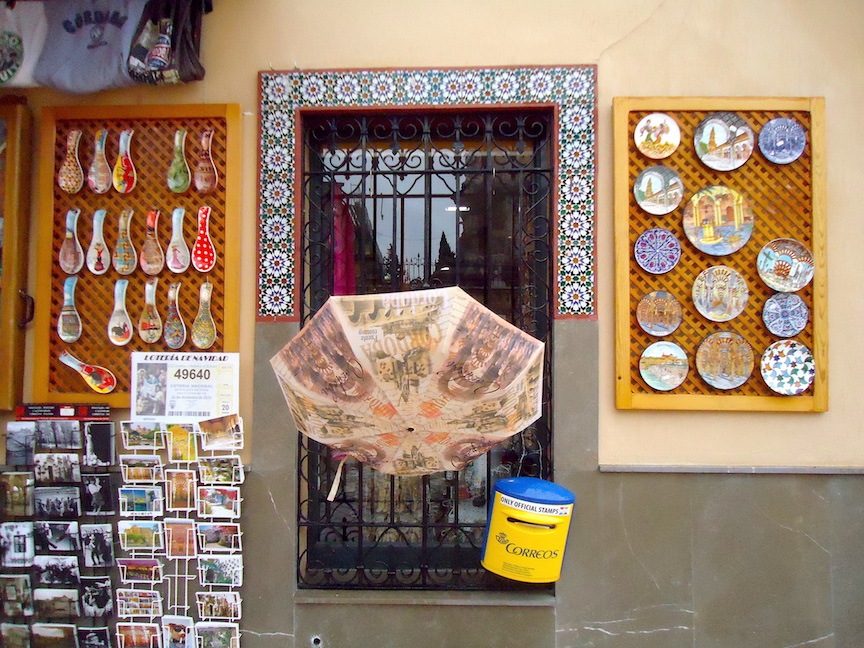As I walked around southern Spain’s Andalusia district, the one thing that kept me company was the multi-coloured, geometric tiles. Initially, it was their attractive patterns that drew me towards them. Usually in two or three colours, these tiles are seen lightly bordering the edges of windows, or visibly etched into palatial walls. Their psychedelic beauty seemed to narrate the history of the land.
As I delved into the history of these tiles, my interest grew further. Travelling through Andalusia I noticed how the art and architecture bore heavy resemblance to Islamic artistic work. I learnt that these Mudejar tiles are representative of the Moorish influence in Spain.


After the 8th Century, during the Reconquest, there was a minority of Muslims who continued staying in this part of Spain. They were ruled by Christian leaders but permitted to follow their own culture and practices. This group, also known as Mudejar, were highly skilled craftsmen. And the tiles I saw around Andalusia were their creations.
A mix of Moorish and Christian influence, my first brush with these tiles was in Cordoba. Walking around the quiet lanes of the town on an overcast day, I saw a tile or two on the doors of private homes. As the shops opened up, I keenly observed the souvenirs. Along with the popular Spanish fans and filigree jewellery, I saw products with similar designs as on the tiles. These designs were of the hexagonal star (as I’ve seen in synagogues), teardrops, circles and unfamiliar intricate drawings. Panning my head around the shop, the ceramics caught my eye. The Mudejar tile—some round, some square—had been replicated on plates, as fridge magnets and other attractive souvenirs. They seemed to create a pattern of religious harmony.
Read: A Morning Stroll in Córdoba, Spain


Exploring Cordoba later in the day, the Mezquita is the most prominent example of this cultural amalgamation. With a courtyard, multiple doors, the bell tower and an extensive indoor space with the Naves of Abd-ar-Rahman I, Chapel of Saint Teresa and treasure, mihrab (the arch which points the direction of Mecca) and the main chapel along with the transept and the choir, this Mosque-Cathedral has beautifully blended Christianity and Islam. I noticed the work on mihrab—the blue, golden inlay motifs, which was in sharp contrast to white floral ceiling and the deep mahogany of the main alter or the Capilla Mayor. Again a union of Moorish artwork with Baroque boldness. While marvelling at this historic wonder, I realised how the simple geometric shapes were actually a consequence of the cultural balance and tolerance that prevailed over the land.
I thought this relationship of tolerance was limited to Cordoba until I saw it more pronounced in Seville. The Mudejar tiles continued contributing to this proof. From decorating the windows of Seville’s Tourist Office to the numerous inferences in the Royal Alcazar, I grew strongly infatuated with them.
Another instance of this cultural blend is the Palace of King Don Pedro (Peter the Cruel of Castile) and perhaps the epitome of this exquisite Moorish work. From the entrance corridor’s ceramic tiles to the horseshoe arches of Patio de las Doncellas, everything exhibits the Islamic influence. The patio is a courtyard with a long pool decorated with pale golden inlay work on the arches and is surrounded by numerous rooms or salons. Such a patio amidst a palace is an essential architectural feature of the Moors.
Read: First Glances of the Sepia Town of Segovia, Spain


Walking into the rooms of the palace, I noticed the white marble on the arch of the doorway, etched with light green and blue patterns. The blue I deciphered were Arabic words. King Don Pedro was a Christian king, who was an ardent admirer of the Moorish artistic creations. And so he had hired skilled architects and craftsmen to design his palace.
The most imposing in this palace was the Ambassadors’ Hall. The four walls of the Hall appeared to be a build up to the daunting golden cupola. Each wall perfectly layered with horseshoe arches, mesh windows, and finally the ceiling. The colours only alternated between white, blue and gold. I realised how the work of the Mudejars had evolved since my first encounter with them in Cordoba.


Not only were these tiles used to adorn palaces and historic sites, but I also found them in one of Seville’s oldest bars. El Rinconcillo, established in 1670, is hugged by the these tricoloured, glazed ceramics. The most prominent was the octagonal motifs behind the bar. There were beautiful floral inlay and vine motifs along with the customary diamonds in different sections of the restaurant too. I couldn’t help but admire the richness and finesse they added to the ambience.
I wondered how the ceramic tiling had stitched cultures and space through time. And how in arts there are no divides.
Read: Madrid in a Day
Where else does art unravel history of the land?
Note: I was invited to this media trip by Tourism Office of Spain and Turkish Airlines.
To see more photos from my travels Like my Facebook Page and follow me on Instagram.






Andalusia is a favorite for me. I traveled to Seville, Cordoba & Granada and found the Mudejar style such a beautiful surprise. A church with Muslim architectural influences is a great story for today’s times no?